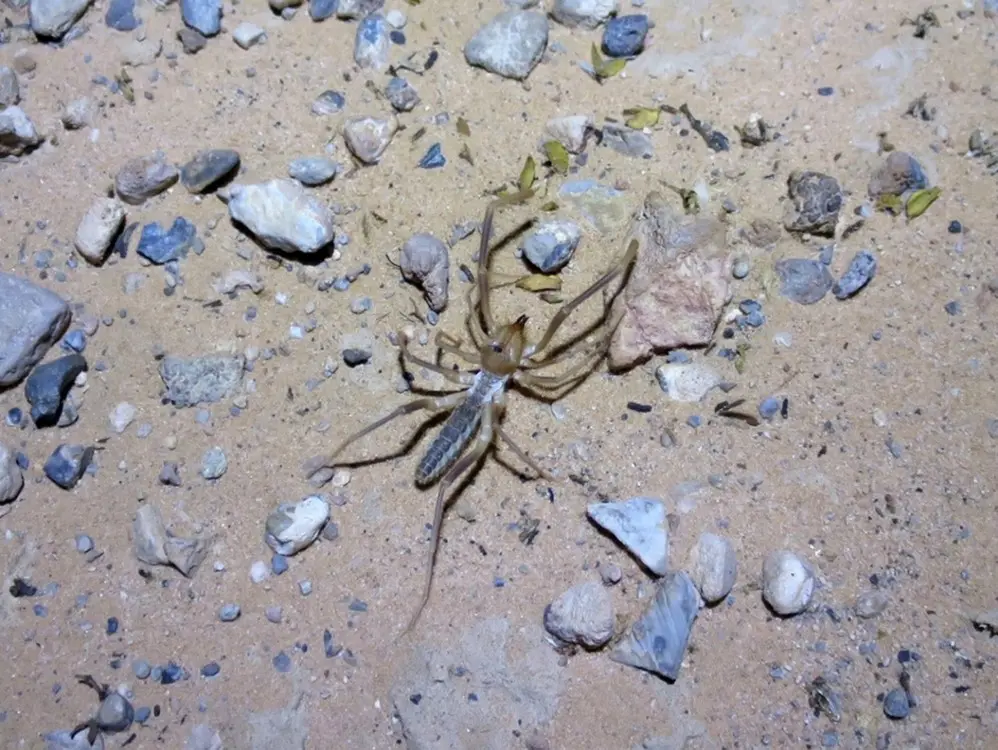The Solifuge

A HALLOWEEN COSTUME? WHO NEEDS THAT?
Solifuges (order solifugae; also called solpugids, solfugids, windscorpions, sun spiders, and camel spiders) are members of the arachnid family, and distant relatives of scorpions and spiders. They are a separate order, Solifugae, taken from Latin and meaning “those who flee the sun.” Though the common name “wind scorpion” is partly accurate – they do run like the wind, and the common name “sun spider” does refer to their dislike of exposure to daylight, both names can be confusing, since these always-hungry invertebrates are neither scorpions nor spiders. Experts suggest that the group should really be called “solifuges.” And frankly, they can “come as they are” on Halloween night!
With their speed (up to ten miles per hour), their faces don’t need masks for the annual Halloween Ball, and “tough-guy-or-gal” defense displays. It’s no surprise that solifuges feature as characters in many urban legends. A roughly two century-old myth from Iraq that says, “venomous solifuges a foot long lay eggs under the skin of camels, run 25 miles-an-hour, and scream like banshees,” is untrue. So is the legend from the American Southwest that says, “they run down deer and kill them with a supposed venomous bite”. A myth from European settlers in southern Africa call them, “hair cutters (haarskeerders) or beard cutters (baardskeerdors)” in that they “literally cut hair or beards off to use for nesting material”.
About 1,000 species of solifuges are known worldwide, and over 230 species range over North America (north of Mexico). Most North American species, like others around the world, favor warm, arid habitats. At least one species, though, is found solely in the wetter habitats of Florida.
Most solifuges are nocturnal, venturing out of their protected hiding places in (or under) rocks, boards, logs, burrows, and the stalks of plants after dark to search for food. Occasionally a solifuge will turn up inside a building (more on that to come).
The bulk of the menu at the “Solifuge Café” is made up of insects. However, a solifuge will consume just about any creature small enough for it to capture and subdue, including scorpions, spiders, and smaller solifuges, millipedes, and even small lizards, birds, and mammals! A hunting solifuge zigzags rapidly about, probing into nooks and crannies with its leglike sensory pedipalps, and almost never staying still for long.
Though solifuges have no venom, they do have the largest jaws for their size of any terrestrial invertebrate. Their jaws (called chelicerae) are armed with teeth that look like crab claws. These are heavily muscled and move independently, seeming to chew up and down and side to side at the same time. Yikes!!! Solifuges really do need to eat – they have high metabolic rates and are sometimes compared to shrews. Females have been observed eating such large meals that they literally cannot walk away afterward!
A solifuge “moment”… or “Uh-oh! What (or who) have I just put my foot on?”
I was up in the middle of the night to feed a baby antelope ground squirrel, and had padded barefoot in the dark to my refrigerator to get her formula. By then, somebody was actively wriggling (vigorously) under the arch of my left foot! I then switched on the overhead kitchen light, picked my foot straight up, and got my first-ever close look at what we then called a solpugid. He (or she) was not pleased with me, but luckily didn’t seem to be hurt, spinning around in a full circle with huge jaws gnashing the air and pedipalps raised like an angry front-end loader before dashing away very quickly to hide under a kitchen cabinet!
Fortunately, solifuges are basically harmless to people and to pets, though a bite from a trapped and frightened solifuge can be painful but not (generally) medically significant. Like the one I met in my kitchen long ago, most just want to run away and hide rather than fight. These arachnids are mysterious and not well known – anyone looking for a research project?
– By Chris Leavitt, President; photo: Jim Boone, BirdandHike.com
Please enjoy these YouTube videos:
The Solifuge New Atlantis Wild 2:03
Camel Spiders: Neither Camels nor Spiders thebrainscoop 7:36
Solifuge or Sunspider hunting and feeding on harvester Termites Dean Van der Lith 1:55
